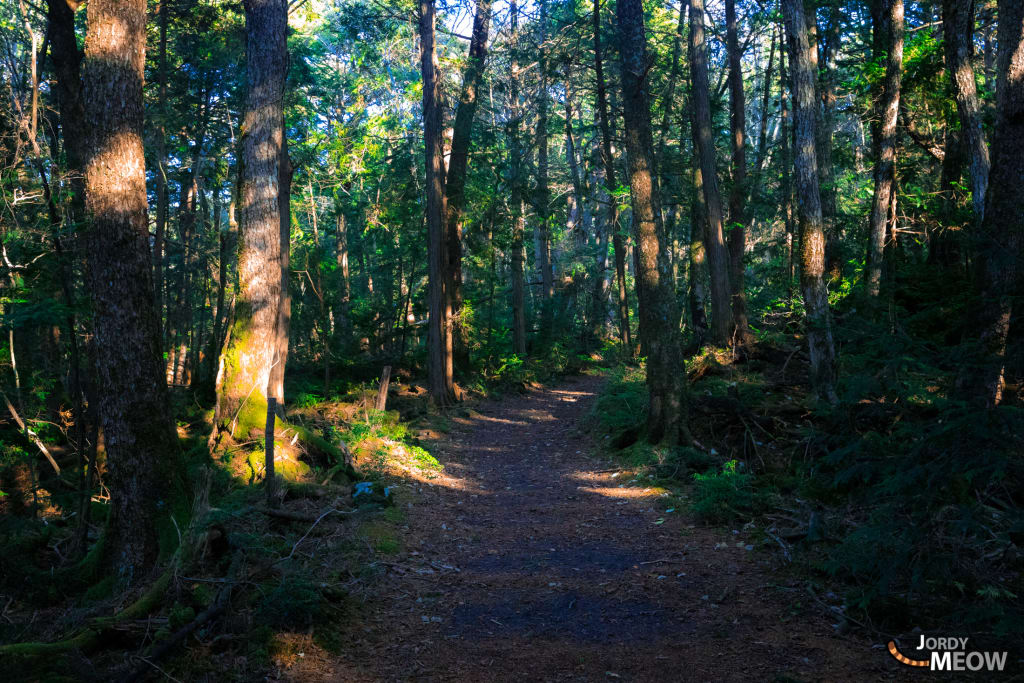10 Chilling Facts about Japan's Aokigahara Forest, the "Suicide Forest"
Delving into the Dark Mysteries of Aokigahara, Japan's Haunting "Suicide Forest"

Nestled at the base of Mount Fuji, Japan's Aokigahara Forest, famously known as the "Suicide Forest," captivates the imagination with its haunting aura and dark history. This enigmatic forest has become notorious for its high suicide rates, drawing countless curious visitors and researchers. In this article, we delve into the depths of this eerie woodland to uncover ten bone-chilling facts about this Dark corner where troubled souls come to put a tragic end to their life in a silent yet horrifying way. Forest's grim history serves as a sobering reminder of the struggles faced by individuals in their darkest moments. Signs and warnings scattered throughout the forest urge visitors to reconsider their actions and seek help, bridging the gap between past tragedies and future hope.
The forest's haunting memorials and annual clean-up efforts reflect the Japanese cultural value of respect for the deceased, ensuring that the lives lost are honored and dignity is restored. The presence of psychologist patrols showcases a collective commitment to addressing mental health concerns and extending compassion to those in need. This enigmatic forest has become notorious for its high suicide rates, drawing countless curious visitors and researchers. In this article, we delve into the depths of this eerie woodland to uncover ten bone-chilling facts, shedding light on its macabre reputation.
Fact 1: A Grim Reputation
Perched at the base of Mount Fuji, Aokigahara Forest, commonly known as the "Suicide Forest," carries a grim reputation that casts a somber shadow over its ancient trees. The forest's haunting association with despair and tragedy has etched its name in the annals of notoriety, drawing both fascination and trepidation from those who dare to step foot within its depths. The dark reputation of Aokigahara Forest stems from its historical connection to suicide. For decades, individuals grappling with anguish and hopelessness have sought solace within the forest's eerie embrace, succumbing to its silent allure. The dense foliage and secluded nature of the forest create an isolated sanctuary, shielding their final acts from prying eyes. Each tree bears witness to untold stories of despair, woven into the fabric of the forest's sorrowful legacy.
The somber reputation of Aokigahara Forest has been perpetuated by various cultural depictions, cementing its status as a place of macabre fascination. Films, literature, and media portrayals have showcased the haunting allure of the forest, amplifying its association with tragedy and melancholy. The forest has become a haunting symbol, shrouded in a mix of horror and morbid curiosity. As one steps into the labyrinthine pathways of Aokigahara Forest, an overwhelming sense of desolation and solemnity envelopes the surroundings. The atmosphere feels heavy, laden with the weight of past sorrows. The trees stand as solemn sentinels, their branches reaching out like ghostly apparitions, whispering tales of anguish and despair.
Fact 2: A Dark History
Steeped in mythology and dark legends, Aokigahara Forest has long been associated with demons and yūrei, vengeful spirits from Japanese folklore. Locals believe that these spirits roam the forest, contributing to the sense of foreboding that permeates its atmosphere. The forest's macabre reputation is rooted in its history as a location where the Japanese would abandon the elderly or infirm during times of famine or hardship. This act, known as ubasute, has left an indelible mark on the forest's collective memory, fueling its dark mythology.Ubasute, meaning "abandoning the elderly," was a cultural practice in which elderly family members, considered burdensome during times of scarce resources, were taken to remote and desolate locations to die. Although the historical accuracy of ubasute within Aokigahara Forest is debated, the forest's association with this practice has become entrenched in local folklore. It is said that the spirits of those abandoned in the forest, their souls tormented by their tragic fate, still linger among the trees.
Legends of vengeful yūrei haunting Aokigahara Forest further heighten its sinister reputation. According to Japanese folklore, when someone dies by suicide, their soul may transform into a yūrei, a restless spirit trapped in the mortal realm. These malevolent beings are believed to prey on lost souls, luring them deeper into the forest's depths and driving them to contemplate their own demise. As visitors explore Aokigahara Forest, they can't help but feel the weight of its history and the echoes of the past. The forest becomes a battleground between the living and the departed, a place where the veil between worlds grows thin, and the boundaries of reality blur. The dark history and supernatural legends surrounding Aokigahara Forest serve as a chilling reminder of the fragility of life and the enduring power of myth and folklore.
Fact 3: Magnetic Anomalies
The dense volcanic soil and the presence of magnetic iron deposits in the area give rise to peculiar compass behavior within Aokigahara Forest. Magnetic anomalies can cause compasses to malfunction, disorienting even the most experienced hikers and adding an unsettling element to the forest's mystique. Researchers have documented cases of compass needles spinning aimlessly or pointing in unusual directions, leaving visitors with a profound sense of unease. Although scientific explanations exist for these magnetic fluctuations, they contribute to the otherworldly ambiance that defines Aokigahara Forest.
Fact 4: The Forest's Unnerving Silence
Despite being a vast woodland, Aokigahara Forest is eerily quiet. The thick vegetation blocks external noises, creating a peculiar stillness that adds to the haunting atmosphere. This silence can be overwhelming and unsettling for those venturing into its depths. The absence of chirping birds and rustling leaves lends an eerie quality to the forest, heightening the sense of isolation and solitude. The silence resonates with visitors, leaving an indelible impression long after they have left the forest's confines.
Fact 5: Warnings and Signs (250 words)
To discourage potential suicides, authorities have placed signs throughout the forest, urging visitors to reconsider their actions and seek help. These signs serve as a constant reminder of the forest's tragic past, warning those who venture in of the possible consequences. Messages convey compassionate pleas, providing hotline numbers and messages of hope. While these signs aim to raise awareness and offer support, their presence also serves as a grim reminder of the forest's troubled history. The juxtaposition of natural beauty and somber warnings underscores the complexities surrounding Aokigahara Forest.
Fact 6: A Living Memorial
Within Aokigahara Forest, numerous reminders of those who have taken their lives can be found. Personal belongings, notes, and memorials are scattered throughout the woodland, serving as haunting reminders of the lives lost within its confines. These mementos act as a living memorial, testifying to the deep emotional struggles faced by those who ended their lives in the forest. Visitors often stumble upon abandoned items such as shoes, photographs, or letters, each carrying a poignant narrative of despair. While some objects remain untouched, others are carefully arranged by volunteers who periodically venture into the forest to honor the deceased and offer solace to their grieving families.
Fact 7: The Forest's Cultural Depictions
Aokigahara Forest has captured the attention of various artists and filmmakers, serving as the backdrop for several novels, movies, and documentaries. These creative works often explore the forest's dark history, further perpetuating its eerie reputation. The haunting allure of Aokigahara Forest has inspired stories that delve into the psychological depths of its visitors, examining themes of guilt, despair, and supernatural encounters. Through artistic portrayals, the forest's enigma has seeped into popular culture, reinforcing its status as a place of mystery and fascination.
Fact 8: Psychologist Patrols
To combat the high suicide rates, volunteers, including psychologists, conduct regular patrols in Aokigahara Forest. Their aim is to provide support and intervention to individuals in distress, offering a glimmer of hope amidst the darkness. Equipped with empathy and training in crisis intervention, these dedicated volunteers traverse the forest, actively engaging with visitors and extending a helping hand to those on the edge. The presence of these patrols emphasizes society's commitment to addressing mental health concerns and providing resources for those contemplating suicide. While their efforts cannot erase the forest's haunting history, they embody a collective determination to save lives and promote mental well-being.
Fact 9: Respect for the Deceased
Japanese culture places great emphasis on respect for the dead. Consequently, local authorities and volunteers organize annual clean-up efforts within the forest to locate and remove the remains of those who have died by suicide. The purpose is to provide closure to grieving families and restore dignity to the deceased. These meticulous searches aim to ensure that no trace is left behind, paying homage to the lives lost and preserving the forest's sacredness. Despite the grim task, the clean-up efforts stand as a testament to the deep-rooted cultural values of compassion and respect within Japanese society.
Fact 10: A Sanctuary for Life
Despite its grim reputation, Aokigahara Forest is home to a diverse range of plant and animal species. The forest's unique ecosystem serves as a sanctuary for various wildlife, offering a striking contrast to the haunting stories that surround it. Aokigahara supports a rich diversity of flora, including mosses, ferns, and unique tree species that thrive in the shade of towering evergreens. Birdsong and the rustling of small animals remind visitors that life continues to flourish amidst the somber atmosphere. This delicate balance between life and death creates an intriguing paradox within the forest, evoking a sense of awe and introspection.
Conclusion
Japan's Aokigahara Forest, the infamous "Suicide Forest," remains a place of eerie fascination and chilling history. With its dark past, magnetic anomalies, and silent expanse, the forest continues to captivate the imagination of those who dare to explore its depths. But beyond tales of despair and haunting legends, Aokigahara Forest serves as a poignant reminder of the importance of mental health awareness and suicide prevention. As efforts to address these critical issues persist, may the forest find healing and transformation, shedding its macabre reputation and embracing hope for the future. As we conclude our exploration of the secrets of Aokigahara Forest, let us not forget the lessons it teaches us. It may serve as a haunting reminder of the urgent need to prioritize mental health, break the stigma surrounding mental illness, and extend a helping hand to those who are struggling. In the darkness of Aokigahara Forest, may the whispers of hope grow louder, dispelling the shadows and guiding those in despair toward the light. By coming together, supporting one another, and embracing the complexity of the human experience, we can strive for a future where the chilling legends of Aokigahara Forest become tales of resilience, survival, and triumph over darkness.
About the Creator
Enjoyed the story? Support the Creator.
Subscribe for free to receive all their stories in your feed. You could also pledge your support or give them a one-off tip, letting them know you appreciate their work.






Comments
There are no comments for this story
Be the first to respond and start the conversation.